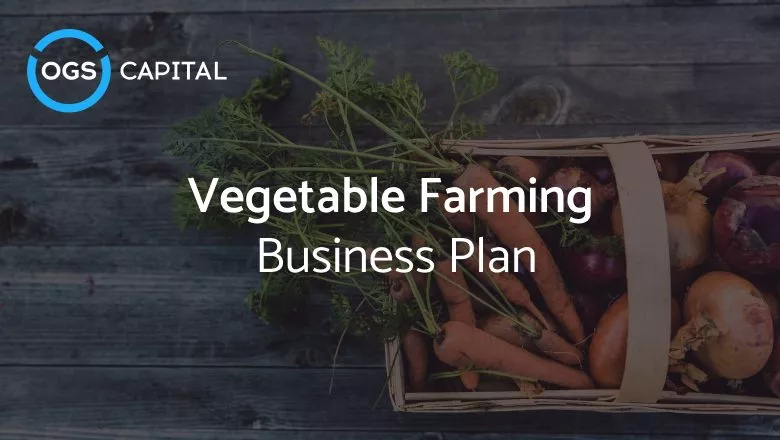Table of Content
As explained in our farm business plan example, vegetable farming is booming. More and more people are becoming aware of the benefits of eating fresh vegetables for their health, environment, and society. According to Statista, the global vegetable market can reach $1.08 trillion in revenue in 2024, with an expected annual growth rate of 6.89% from 2024-2028.
Starting a successful vegetable farming business requires appropriate planning, investment, knowledge, and marketing. Without proper foresight, new farmers face pitfalls like investing too much upfront, failing to find customers, or getting overwhelmed by the workload.
This vegetable farming business plan sample helps you:
- Tackle challenges,
- Explore benefits,
- Assess market potential,
- Identify business models and
- Create a targeted marketing plan for your vegetable farm.
By the end, you will have a business plan for vegetable farming tailored to your unique situation.
Challenges of the Vegetable Farming Industry
Starting a vegetable farming business involves four main challenges: high initial investment, seasonal and climatic factors, market fluctuations and competition, and regulatory and environmental issues. Here is how you can deal with each challenge:
1. High Initial Investment
As explained in our fruit and vegetable business plan, starting a farming business requires significant capital. According to a report by Starter Story, the average startup costs for a vegetable farm in 2024 are $19,815. Primary startup costs for starting a vegetable farm include:
- Land acquisition or leasing
- Equipment (tractors, tillers, irrigation systems, etc.)
- Seeds and seedlings
- Fertilizers and pesticides
- Labor costs
- Licensing and permits
- Marketing and advertising expenses
- Packaging and transportation costs
- Storage facilities
- Insurance
Tips to reduce initial investment for a vegetable farming business:
- Start small and expand gradually.
- Consider leasing or sharing equipment.
- Explore financing options or grants.
- Invest in cost-effective technology.
- Collaborate with other farms for bulk purchases.
- Optimize resource usage to reduce expenses.
- Focus on high-yield crops for better returns.
- Develop a vegetable growing business plan for financial guidance.
2. Seasonal and Climatic Factors
Vegetable farming is highly dependent on the weather and the seasons. Farms facing failures due to seasonal and climatic factors are a growing concern, particularly with the impacts of climate change.
Tips to adapt to seasonal and climatic factors for a vegetable farming business:
- Rotate and diversify crops.
- Use greenhouses for year-round production.
- Monitor weather forecasts regularly.
- Utilize row covers or frost protection methods.
- Focus on planting and harvesting resilient crops.
- Stay informed on climate change.
- Have contingency plans for extreme weather events.
3. Market Fluctuations and Competition
The vegetable farming industry is very competitive and dynamic. The competition can come from other farmers with lower production costs, higher quality standards, or better marketing strategies.
Tips to overcome market fluctuations and competition challenges in a vegetable farming business:
- Diversify produce to meet market demands.
- Build direct relationships with local markets.
- Use technology for forecasting and planning.
- Engage in farmers’ markets or CSA programs.
- Emphasize quality to stand out.
- Offer unique or specialty crops.
- Collaborate for collective marketing.
- Adapt production to market trends.

4. Regulatory and Environmental Issues
A vegetable farming business is subject to various laws and regulations that govern the quality, safety, and sustainability of vegetable products and practices. Some of these regulations include:
- Federal Insecticide, Fungicide, and Rodenticide Act (FIFRA)
- Food Quality Protection Act (FQPA)
- Clean Water Act (CWA)
- Safe Drinking Water Act (SDWA)
- Soil Conservation and Domestic Allotment Act
- Fair Labor Standards Act (FLSA)
- Food Safety Modernization Act (FSMA)
Tips to address the regulatory and environmental issues in a vegetable farming business:
- Research local regulations and obtain necessary permits.
- Develop a sustainability plan, like a garlic farm business plan for eco-friendly farming.
- Implement effective waste management strategies.
- Adopt sustainable farming practices to minimize environmental impact.
- Stay updated on evolving laws.
- Collaborate with agencies for guidance.
- Regularly assess and mitigate environmental risks.
- Train staff on compliance and best environmental practices.
The Benefits of a Vegetable Farming Business
Despite the challenges, vegetable farming offers a unique business opportunity with stable demand, diverse income streams, and scalability. Profit margins often range from 20-35%. The benefits of starting a vegetable farming business include:
1. Financial Benefits
- High profit margins.
- Comparatively lower initial investments.
- Ability to scale and expand to meet demand year-round.
- Multiple pricing models – D2C, restaurants, processed goods, etc.
- Eligible for agriculture subsidies, grants, and financial incentives.
- Vertically integrated with value-added products to maximize revenues.
2. Market Benefits
- Constant and growing consumer demand for fresh vegetables.
- Less susceptibility to market volatility compared to commodity field crops.
- Year-round production capabilities with greenhouse infrastructure.
- Ability to capitalize on the increasing popularity of plant-based diets and locally grown food.
- Direct marketing opportunities through farm-stands, farmers markets, CSAs, etc.
3. Operational Benefits
- Shorter crop cycles and ability to diversify crops throughout the seasons.
- Lower equipment costs compared to commodity crop operations.
- Adaptable to smaller land holdings in peri-urban areas.
- Farm labor is readily available compared to field crops.
- Lower regulatory barriers to entry compared to livestock or cash crops.
Healthy profit margins, diversified income streams, increased market demand, and access to growing niche markets make produce production a promising business model. Crafting a business plan for an E2 visa can also be beneficial if you plan to expand your farming business internationally.
Immigration business plan
The Value of Vegetable Farming Market
The vegetable farming market is large and diverse, with various segments and niches. According to a report by The Business Research Company, the global vegetable farming industry market is expected to grow from $1.65 trillion in 2023 to $1.76 trillion in 2024 at a CAGR of 6.5%. It’s projected to reach $2.17 trillion in 2028 at a CAGR of 5.4%.
The major factors driving the growth of the vegetable farming industry include:
- Population growth
- Health and wellness trends
- Urbanization
- Changing dietary patterns
- Government policies
- Climate change impact
- Global trade dynamics
- Consumer preferences
- Supply chain resilience
- Water scarcity concerns
The major markets for farming are Asia-Pacific, Europe, North America, and South America, with China, India, Nigeria, the Dominican Republic, and the US being the top five producers of vegetables, according to the World Population Review.
| VEGETABLE PRODUCTION BY COUNTRY (2024) | ||
| Country | Production Combined(Million Metric Tons) | % Contributed |
| China | 749 Million | 55.60% |
| India | 200.3 Million | 14.87% |
| Nigeria | 137.8 Million | 10.23% |
| Dominican Republic | 48.2 Million | 3.58% |
| United States | 47.8 Million | 3.55% |
| Indonesia | 34.1 Million | 2.53% |
| Thailand | 33.4 Million | 2.48% |
| Ghana | 33 Million | 2.45% |
| Russia | 31.8 Million | 2.36% |
| Turkey | 31.7 Million | 2.35% |
Business Opportunities in the Vegetable Farming Business
There are several business opportunities to capitalize on increasing consumer demand for fresh, local produce. Here are some of the top opportunities in the farming sector:
1. Organic Vegetable Farming
What Is Organic Vegetable Farming? Organic vegetable farming involves cultivating vegetables without synthetic pesticides or fertilizers. Instead, it relies on natural methods to maintain soil fertility and control pests. Check our organic farming business plan to learn more.
Ideal For – Environmentally conscious producers seeking nutritious and chemical-free produce.
Organic Vegetable Farming Business Plan
- Research organic farming practices.
- Identify suitable land for cultivation.
- Obtain organic certification.
- Cultivate a variety of in-demand produce.
- Establish partnerships with local markets.
Opportunities:
- Growing demand for organic produce.
- Potential for premium pricing.
- Access to niche markets like farmers’ markets and organic grocery stores.
Challenges:
- Higher production costs compared to conventional farming.
- Compliance with organic certification standards.
2. Hydroponic Vegetable Farming
What Is Hydroponic Vegetable Farming? Hydroponic vegetable farming is growing plants in a soilless system where nutrient-rich water solutions deliver essential minerals directly to the roots.
Ideal for – Urban areas with limited space, regions with water scarcity, and individuals interested in high-tech agriculture.
Hydroponic Vegetable Farming Business Plan
- Select suitable hydroponic systems (e.g., NFT, DWC).
- Source quality seeds and nutrient solutions.
- Establish a distribution network targeting local markets or restaurants.
- Invest in technology for climate control and monitoring.
- Ensure proper training for staff on hydroponic techniques.
Opportunities:
- Efficient water usage.
- Year-round production.
- Potential for premium pricing.
Challenges:
- High initial setup costs for equipment and technology.
- Technical expertise is required for managing hydroponic systems.
3. Vertical Vegetable Farming
What Is Vertical Vegetable Farming? Vertical vegetable farming involves growing produce in vertically stacked layers or vertically inclined surfaces. This innovative approach maximizes space utilization by taking farming to new heights.
Ideal For – Urban dwellers, restaurants, and communities with limited space but a growing demand for fresh, locally grown produce.
Vertical Vegetable Farming Business Plan
- Select a suitable vertical farming system (e.g., tower gardens, hydroponic towers).
- Choose high-yield crop varieties that thrive in vertical setups.
- Optimize lighting and irrigation systems for efficient growth.
- Establish partnerships with local markets or restaurants for direct sales.
- Implement sustainable practices for resource efficiency.
Opportunities:
- Maximizing space utilization for increased yields.
- Providing fresh produce locally year-round.
- Catering to the growing demand for sustainable agriculture practices.
Challenges:
- Initial setup costs are significant.
- High energy consumption.
- Limited crop varieties compared to traditional outdoor farming.
4. Value-added Vegetable Farming
What Is Value-Added Vegetable Farming? Value-added vegetable farming involves processing and enhancing the value of raw produce through methods like canning, pickling, or creating gourmet products. This adds convenience and uniqueness to the product.
Ideal For – Farmers looking to diversify their product offerings, cater to consumer preferences for convenience, and capitalize on the artisanal food trend.
Value-added Vegetable Farming Business Plan
- Identify popular value-added products.
- Source high-quality produce for processing.
- Develop unique recipes and packaging to differentiate products.
- Establish distribution channels through farmers’ markets, specialty stores, and online platforms.
- Maintain strict quality control and food safety standards.
Opportunities:
- Allows monetization of surplus or lower-grade fresh produce.
- Offers products with longer shelf life.
- Captures higher margins.
Challenges:
- Additional investments in kitchen equipment and facilities.
- Licensing requirements for processed food production.
- Market competition from large food manufacturers.
Marketing Plan for a Vegetable Farming Business Plan
A marketing plan section of a state farm business plan outlines the strategies and actions that a business will use to achieve its marketing goals and objectives. If seeking funding, a pitch deck services provider can help create a compelling presentation to attract investors.
A marketing plan for a small vegetable farm business plan should include:
- Target Market
- Competitive Analysis
- Marketing Strategies
- Pricing Strategy
- Distribution Plan
- Branding
- Sales Forecast
- Marketing Budget
Here’s a marketing plan section from a sample vegetable farming business plan of a business called ABC Farms:
Target Market
Our target markets include:
- Local Restaurants
- Farmers Markets
- Community Supported Agriculture (CSA) Members
- Grocery Stores
- Schools and Cafeterias
- Food Cooperatives
- Health-conscious consumers
Competitive Analysis
Our main competitors are the large-scale conventional producers. Our competitive advantage is our commitment to sustainable practices, focus on soil health, and fresh, high-quality produce.
Marketing Objectives
- Increase brand awareness by 20%
- Expand customer base by 15%
- Increase direct-to-consumer sales revenue by $10,000
- Establish 5 new partnerships
- Achieve a 25% sales increase for new organic products
- Boost social media engagement by 30%
- Participate in 3 events monthly
Marketing Strategies
- Social media marketing
- Email marketing campaigns
- Hosting farm tours and workshops
- Partnership with local restaurants or grocery stores for sourcing
- Participating in farmers’ markets and food festivals
- Implementing a customer loyalty program
- Offering seasonal promotions and discounts
Marketing Budget
As per our vegetable production business plan, our annual marketing budget is $20,000, which will be allocated as per the chart below:

Our promotion will focus on our organic practices, product freshness, and status as a local farm supporting the community. These qualities help attract consumers.
Partner With OGSCapital for Your Vegetable Farming Business Plan
At OGSCapital, we have the experience and expertise to help you start a successful vegetable farm. We are a team of leading business plan writers with over 17 years of experience and 5,000+ satisfied customers across 42+ industries. Additionally, we provide guidance on documents like the EB2 business necessity letter sample, which can support visa applications for business expansion.
Here are some of the reasons why you should choose us for your business plan for vegetable farm:
- We make custom, high-quality, user-friendly business plans for your goals and needs. For example, our FPO business plan template.
- Our experts are from top B-schools with 15+ years of industry experience. We can boost your business position and investor appeal.
- We use reliable research to give you current and relevant data and insights into the industry.
- We connect you with our network of investors. We have helped our clients raise over $2.7 billion in funding.
Contact us today if you are ready to start your vegetable farm or garden business plan.
Download Vegetable Farming Business Plan Template in PDF
Frequently Asked Questions
How profitable is vegetable farming?
US vegetable farmers’ profits vary widely. Mid-Atlantic direct-market farms earned below $18,500, less than Pennsylvania’s poverty line for two people. But bigger and more diverse farms made more than the median household income in 12 years. US vegetable farms’ profit margins are usually 10-20% of revenue.
What are the best vegetables for farming?
Low-growing greens vegetables like lettuces, spinach, arugula, bok choy, and kale are generally easy to grow and can be successful in various conditions. Other high-income crops for small or backyard growers include strawberries, garlic, and specialty vegetables like heirloom tomatoes and exotic herbs.
OGSCapital’s team has assisted thousands of entrepreneurs with top-rated document, consultancy and analysis. They’ve helped thousands of SME owners secure more than $1.5 billion in funding, and they can do the same for you.













